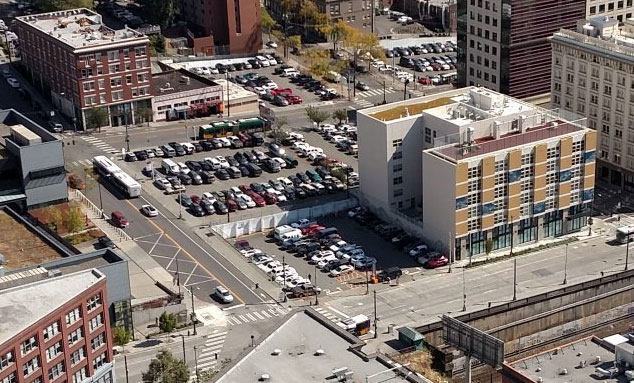Houston is poised to take a big step toward becoming a walkable city.
The city Planning Commission is considering a proposal that would exempt two neighborhoods adjacent to downtown from off-street parking requirements.
Midtown and East Downtown (EaDo) have been proposed as extensions of the downtown area that would allow new developments to be built without requiring a large amount of off-street parking, or any off-street parking at all. The two neighborhoods currently have about 10,000 residents, with strong transit access and plenty of room to grow.
But right now Houston's current code requires 1.66 parking spaces for each two-bedroom apartment. Despite its reputation as a zoning-free city, Houston's parking requirements are fairly high by national standards. The city also has, for example, a high requirement that restaurants provide 10 spaces per 100 square feet. Such rules make the city not just less sustainable, but also less fun.
"A city that requires that 10 paved parking spots exist every time there’s 100 square feet of people dining somewhere will never be an interesting city," one commenter posted on the local real estate site Swamplot. "If you need that much flat pavement everywhere that people like to hang out and cluster, you’re going to concrete and asphalt yourself away from ever having an interesting district."
Jay Crossley, director of the Austin-based nonprofit advocacy group Farm and City, is pleased with the proposed reforms but wishes it went further, including other central neighborhoods or the whole city. But, he says, this is a good start because if Houston is going to become less sprawling, they will need to see huge population growth in these two transit-accessible, center neighborhoods, he says.
"The potential for transit-oriented development is Houston is those two places," he told Streetsblog. "Both areas have the light rail lines and a crazy amount of bus service."
A good amount of multi-family housing has been built in recent years in the two areas, but it's been a weird mix of walkable and suburban, thanks to the parking requirements, Crossley says. For example, the construction of mixed-use grocery-residential mid-rise building was announcedlast year. Meanwhile, a 26-story mixed-use residential tower planned for Midtown will have almost 500 parking spotsfor 347 units.
The City Council will have to approve the changes, which will likely happen before year end, according to Swamplot. Key officials in both neighborhoods say they support the change.
Midtown and EaDO already function a lot like downtown areas. EaDo is home to the city's "Old Chinatown," and is served by both Metrorail's Green and Purple lines. Meanwhile, Midtown is a big nightlife destination that has been growing rapidly. Metrorail runs right down Main Street in Midtown.
Not only could the new rules make room for more people to live in one of the city's most walkable, transit accessible areas, it could also slow gentrification, which could be especially helpful in EaDO, which has a large low-income and homeless population, says Crossley.
The parking reforms come from the Walkable Places Committee, a new group focused on urbanism in Houston organized by Mayor Sylvester Turner, who is pushing a number of exciting reforms.
The move comes around the same time that many Houston institutions are realizing the danger of the city. The Houston Chronicle published a spectacular new reportthis week that documented how the city's car culture kills an average of 640 a year in the metro region. (By comparison, the city of Seattle had just 20 traffic deaths last year.)
The Chronicle pointed out the myriad reasons for the high death toll: lack of speeding enforcement, sprawl and long commutes, and missing sidewalks and bike infrastructure. But a big part of the reason is simply that Houstonians have to drive so far and so often because much of the development has been centered around sprawling highways like the Grand Parkway.






